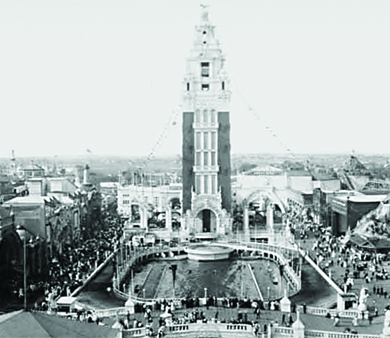| << Chapter < Page | Chapter >> Page > |

Working-class residents also found relief in the diverse and omnipresent offerings of popular culture and entertainment in and around cities. These offerings provided an immediate escape from the squalor and difficulties of everyday life. As improved means of internal transportation developed, working-class residents could escape the city and experience one of the popular new forms of entertainment—the amusement park. For example, Coney Island on the Brooklyn shoreline consisted of several different amusement parks, the first of which opened in 1895 ( [link] ). At these parks, New Yorkers enjoyed wild rides, animal attractions, and large stage productions designed to help them forget the struggles of their working-day lives. Freak “side” shows fed the public’s curiosity about physical deviance. For a mere ten cents, spectators could watch a high-diving horse, take a ride to the moon to watch moon maidens eat green cheese, or witness the electrocution of an elephant, a spectacle that fascinated the public both with technological marvels and exotic wildlife. The treatment of animals in many acts at Coney Island and other public amusement parks drew the attention of middle-class reformers such as the American Society for the Prevention of Cruelty to Animals. Despite questions regarding the propriety of many of the acts, other cities quickly followed New York’s lead with similar, if smaller, versions of Coney Island’s attractions.

The American Experience Timeline of Coney Island shows a timeline, photo gallery, and other elements of Coney Island. Look to see what elements of American culture, from the hot dog to the roller coaster, debuted there.
Another common form of popular entertainment was vaudeville—large stage variety shows that included everything from singing, dancing, and comedy acts to live animals and magic. The vaudeville circuit gave rise to several prominent performers, including magician Harry Houdini, who began his career in these variety shows before his fame propelled him to solo acts. In addition to live theater shows, it was primarily working-class citizens who enjoyed the advent of the nickelodeon, a forerunner to the movie theater. The first nickelodeon opened in Pittsburgh in 1905, where nearly one hundred visitors packed into a storefront theater to see a traditional vaudeville show interspersed with one-minute film clips. Several theaters initially used the films as “chasers” to indicate the end of the show to the live audience so they would clear the auditorium. However, a vaudeville performers’ strike generated even greater interest in the films, eventually resulting in the rise of modern movie theaters by 1910.
One other major form of entertainment for the working class was professional baseball ( [link] ). Club teams transformed into professional baseball teams with the Cincinnati Red Stockings, now the Cincinnati Reds, in 1869. Soon, professional teams sprang up in several major American cities. Baseball games provided an inexpensive form of entertainment, where for less than a dollar, a person could enjoy a double-header, two hot dogs, and a beer. But more importantly, the teams became a way for newly relocated Americans and immigrants of diverse backgrounds to develop a unified civic identity, all cheering for one team. By 1876, the National League had formed, and soon after, cathedral-style ballparks began to spring up in many cities. Fenway Park in Boston (1912), Forbes Field in Pittsburgh (1909), and the Polo Grounds in New York (1890) all became touch points where working-class Americans came together to support a common cause.

Notification Switch
Would you like to follow the 'U.s. history' conversation and receive update notifications?